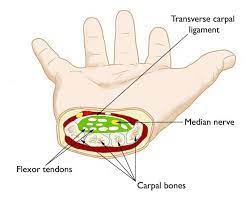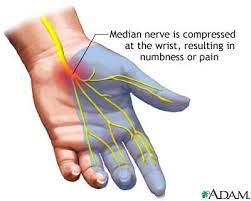Do you use your hands a lot for work? Do you feel pain or numbness into your fingers or wrists? Have you heard of carpal tunnel syndrome before or has a co-worker or family friend mentioned they suffered from carpal tunnel syndrome? What exactly is this syndrome and how do we treat it?
Our carpal tunnel is located at our wrist crease, where it is made up of 8 small bones referred to as carpals and connected by various ligaments. The carpal tunnel provides a protected passageway for our median nerve and our flexor tendons which provide motor and sensor function to our hand and help to open and close our hands, respectively. Carpal tunnel syndrome is a common condition that occurs because the median nerve becomes compressed on within our carpal tunnel. It is more often seen in women and individuals over the age of 40 years old.

What are common causes of carpal tunnel syndrome?
Carpal tunnel syndrome can occur due to multiple factors, but what are the most causes of carpal tunnel syndrome?
- Injury or trauma to the wrist: This can create swelling and inflammation which in turn increases the amount of pressure in the carpal tunnel and therefore affects the median nerve.
- Repetitive strain injuries to the wrist: This is commonly suffered by office workers or manufacturing workers where they repetitively use their hand and wrists. With the repetitive use it can cause swelling and inflammation in the flexor tendons, also causing increase pressure in the carpal tunnel and on the median nerve.
- Anatomical make up: Everyone’s anatomical make up is different. For example, some are born with narrower carpal tunnels, therefore predisposing them to a greater likelihood of the median nerve being compressed.
- Hormonal or metabolic changes: This can include menopause, pregnancy, or thyroid imbalance.
- Joint or bone disease: This can include arthritis, osteoarthritis or rheumatoid arthritis.
What are some of the symptoms associated with carpal tunnel syndrome?
Now that we know what may cause carpal tunnel syndrome, how do we know if we have it? Common symptoms of carpal tunnel syndrome:
- Pain and/or numbness in the affected hand or wrist
- Weakness in the affected hand and wrist (i.e. with gripping objects)
- Pins and needles feelings in the fingers. The will present in the median nerve distribution of the hand which includes the palmar side of the thumb, index finger, third finger and outside half of the ring finger.
- Pain and or numbness that is worse at night, possibly disrupting sleep

What to do first if you think you may have carpal tunnel syndrome?
There are various treatments and strategies to help you feel better but some simple things to try initially include the following. Taking more frequent breaks to rest your affected hand and wrist. One way to monitor this is setting a timer on your phone or watch to go off every 20 minutes to take a break from the task you are doing (i.e. typing on the computer at your desk). Although difficult, trying to avoid the activities that make your symptoms worse. For example, if playing racquet sports makes your pain or numbness worse, then to take a break from that sport is in your best interest. If it is not possible to avoid the task that aggravates you, applying cold packs to the wrist to reduce swelling and inflammation. A general guideline is 10-15 minutes on, 1-2 hours off.
What are treatment options for carpal tunnel syndrome?
A treatment that may benefit you could be a corticosteroid injection, which would be performed by a medical doctor. Another option that may be recommended to you is having carpal tunnel release surgery in order to relieve the compression being placed on your nerve. The previously mentioned treatments are typically performed after conservative treatment has not benefited you. However, it is recommended that conservative treatment such as physiotherapy be tried prior to exploring those options.
How can a physiotherapy help with your hand and wrist pain?

There are many different treatment avenues that a physiotherapist can use to try and lessen the symptoms caused by carpal tunnel syndrome. Initially, the physiotherapist will provide education on the condition and strategies to help avoid aggravation such as activity modification. It has been shown that use of a wrist brace is helpful to provide support and some immobilization to allow inflammation and ultimately reduce compression on the nerve. They may also provide hands on manual therapy to improve range of motion in the affected area. This can also include providing neuromobilization techniques to relief compression on the affected nerve. This may also help to reduce pain and discomfort suffered at the hand and wrist. Additionally, they will likely prescribe an individualized exercise program involving stretching, strengthening and nerve gliding. Multiple modalities may be beneficial such as acupuncture for pain relief and stimulation of healing.
If you think you are dealing with carpal tunnel syndrome, call South Simcoe Physiotherapy in Alliston or Tottenham and one of our health care practitioners will be happy to help!

